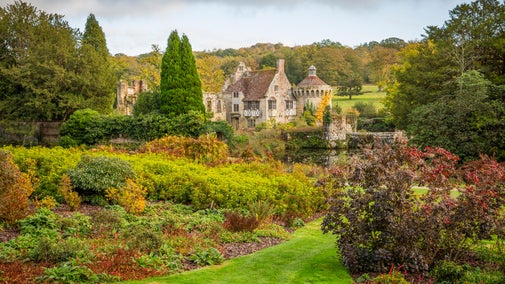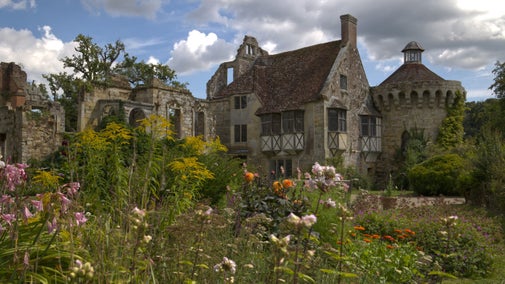
Discover more at Scotney Castle
Find out when Scotney Castle is open, how to get here, the things to see and do and more.

Little Scotney farm on the Scotney Castle estate is the only working hop farm at the National Trust and one of the few remaining hop farms in Kent. Harvesting the hops was an important part of the year for both farmers and the families who travelled to Kent to help; many a happy childhood was spent in the hop picking fields of Kent. Take a step back in time to read Anne's memories of hop picking as a young girl with her family at a farm in Selling, near Faversham.
I remember walking across the concourse of Victoria Station, London, in September 1955 pushing my brother’s pram which was loaded with our clothing and other possessions. I was aged five, could only just see over the hood and, with my mother and brother, was on my way to go hop picking in Kent.
My maternal grandmother, Queenie, had been going hop picking with her family all her life and although not in the best of health she still wanted to leave her home near Gillingham, Kent and spend the month of September in the hop fields of Selling, near Faversham.
My mother, Joyce, was in charge of my brother, Michael’s, pushchair and he was aged nine months. We had set off from home in Essex and travelled to Victoria by train and the second part of the journey into Kent involved travelling by steam train. Queenie met us at Selling station and we then walked to our hopping hut which was to be home for the next week. We continued going hop picking until I was about 10 years old and so I used to miss the first week of each new school year.
Joyce would go down to Selling by car a few days before picking began and having collected Queenie on the way, she would prepare the hopping hut for occupation. The huts were built from grey breeze blocks with a corrugated roof, so Joyce tacked clean, old sheets to the walls where they met the ceiling and rugs were spread on the concrete floor. There was one small window.
The bed was a crude wooden frame with a slatted base and it was in the back-left corner of the hut. Clothes were hung from nails fixed into the wall opposite the foot of the bed and there was a relatively wide plank of wood along the length of the bed which served as somewhere to sit inside.
All her life Queenie had slept on a feather mattress rather like the mattress toppers of today and this was placed on top of a horsehair mattress. She did not deviate from this combination when staying in the hopping hut. The four of us slept in it together and to me as a child it felt like sleeping on a cloud.
I vividly remember lying in bed, my mother and grandmother sitting on the wooden edge of the bed with their backs to my brother and me, hearing them chatting in low voices while we were warm and comfortable in our feather nest.

There was no electricity. Water was fetched from a communal tap outside. There were no flushing toilets, showers or even wash basins. We didn’t particularly notice or care – that was how it had always been. I must say I hated the toilet arrangements: a wooden hut with a wooden seat and a hole in the ground – yuk!
There was no cooker either, so the evening meal was prepared and cooked outside the hut on communal fires, by the women of the families. The farmer delivered bundles of wood each day and the outsides of the saucepans were black because they were placed directly into the fire. I don’t remember what we ate but, like all meals cooked outside, they tasted good.
There were no fridges of course but mobile shops regularly called at the site. As for lighting my grandmother had paraffin lamps in the hut and she had a small paraffin stove inside for heating water for washing and drinks.
Each morning we would walk as a group to the hop field to be picked that day. Once allocated a row we would pull down a bine or two and start picking. I had to pick a basket a day (without many leaves, mind) and from time to time a tractor and trailer would appear and the tally man would weigh our pickings and mark my grandmother’s card accordingly. This was how her earnings were calculated. A man on stilts (known as the pole puller) would go along the rows, unhooking any small pieces of bine caught up on the highest of the wires.
- Anne
Of course, the weather varied. September can deliver an Indian summer but equally can bring a marked turning point between summer and autumn. If it rained conditions were decidedly muddy but it was rare for picking days to be cancelled due to the weather. Misty mornings meant that spiders’ webs were hung with dewdrops that looked like diamonds and the hedgerows were hung with grandfather’s beard. Other wildflowers I remember were corn-cockle, campion, birds’ eye and vetch.
There were often spectacular sunsets. I vividly remember one such evening on a Sunday when a local vicar had come out to conduct Evensong. People stood for the service in the open air and the combination of their singing and the colourful sky was magical.
We took sandwiches to the hop field for lunch – often they were bread and dripping, something we don’t have so much today. We had tea from a flask and a good seal was assured by placing a piece of greaseproof paper between the flask rim and stopper.

When our week came to an end we packed up and headed home, leaving Queenie there for the rest of the month. My mother would then drive back to Selling to pack up Queenie’s belongings from the hut and take everything back to her bungalow near Gillingham. I do recall Queenie was most disappointed the year Joyce decreed she could not go hop picking any more (for health reasons) and so came the end of an era in our family.
Years later I took Joyce to a Pick Your Own fruit farm close to my home in Sussex. ‘Do you know how you should pick blackcurrants?’ the owner asked her. ‘Oh, yes,’ she replied. ‘I grew up on a fruit farm in Kent.’ ‘Where was that?’ he asked. ‘Lower Halstow,’ she said, to which he replied: ‘My family owned a hop farm near there, at Selling.’ Yes, of course, this was the very same hop farm where my family had been going for many, many years.
For Anne, hop picking as a young girl holds many happy memories of time spent in the hop gardens of Selling, Kent. Watch as she reminisces about her days with her mother, grandmother and brother in the hop gardens of Selling, Kent, and life in the hoppers’ huts.
Hop picking is a key part of the Scotney estate’s history. If you have any memories of hop picking at Little Scotney Farm or other farms in Kent that you'd like to share please email them to scotneycastle@nationaltrust.org.uk.

Find out when Scotney Castle is open, how to get here, the things to see and do and more.
Discover the long and rich history of Scotney Castle and its journey with the Hussey family from moated castle to idyllic country estate.

Discover the Picturesque garden and wider estate at Scotney Castle. Take time to look around as you explore and discover endless vistas and interesting angles for photographs and reflection.

From secret doors to ornate furniture and amazing collections of art, costume, books and silverware, find out about the house at Scotney Castle and how the Hussey family made it a home.

There's nothing better than a warm spring day: fresh air, sunshine and food enjoyed in the outdoors. Whether you're going for the full lunch option or just a snack to keep you going 'til tea, there's a full range of savouries and bakes to entice you. And if the English weather doesn't play ball there'll always be jacket potatoes and fish finger sandwiches ...
